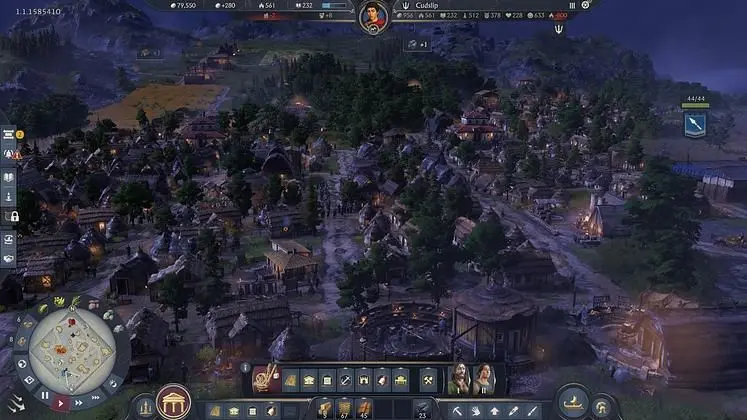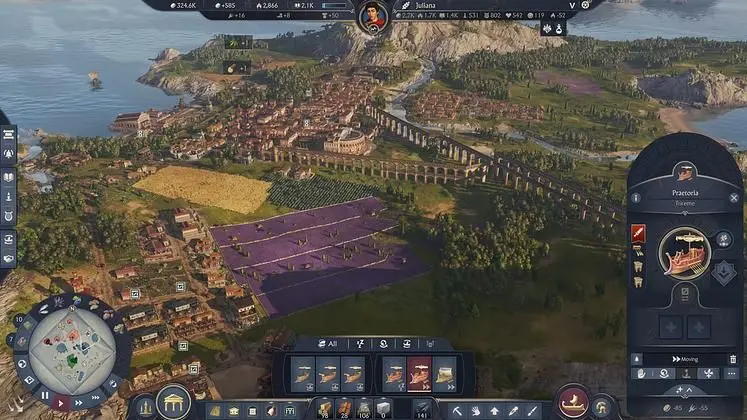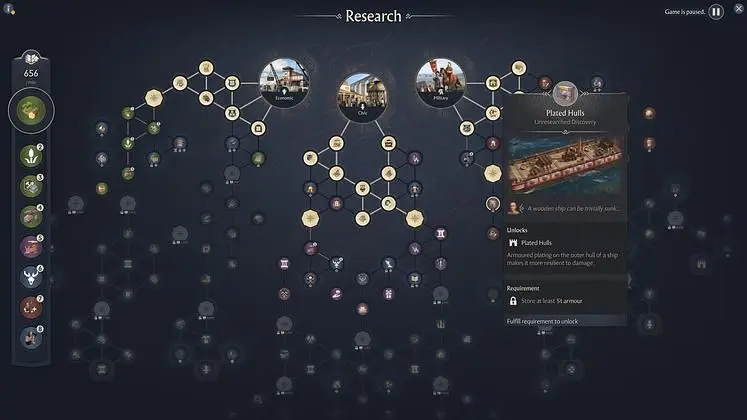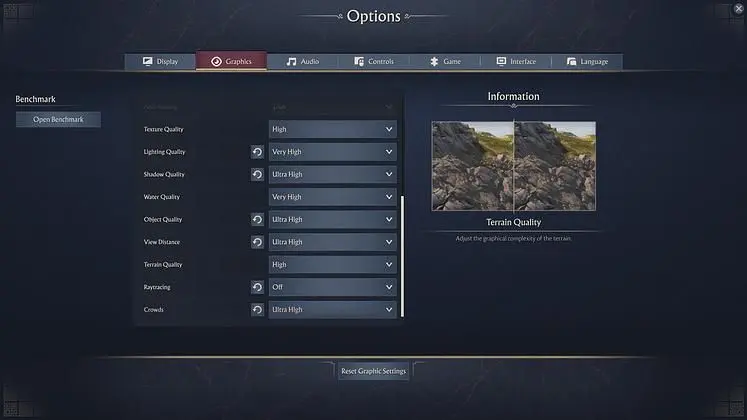The Anno series has stood the test of time thanks to its distinctive city building formula, even when its streamlined far-future experiments risked alienating its fanbase. There’s a certain unmistakable thrill to setting up production chains, settling islands in search of new resources, as well as watching your cities grow and your population thrive, supported by a far-reaching network of trade routes.
Anno 117: Pax Romana takes the series on its longest journey into the past, operating on a different scale than its more industrially-minded predecessor. Across both the regions of Latium and Albion, you’re dealing with smaller cities, less demanding production chains – at least until the final population tiers –, and a generally laid-back city building experience that puts more control in your hands.
Gone are the days of endless AI quest spam that pressures you into completing tasks when your attention is focused elsewhere. Instead, you choose when to start quests offered by characters or pick contracts from their lighthouses if you’re looking to earn some extra denarii.
The latest entry in the series also treats both regions as relative equals, rather than having one be the other’s satellite. Although the campaign does start in Latium before sending you to Albion, Endless mode lets you choose where to start. Since you’re no longer depending on goods from across the sea, you can take your time and get to grips with one’s mechanics before moving on to the next.
To upgrade your citizens to the next tier, you must only fulfill a single need in each category. This change grants additional flexibility and makes it a bit easier for newcomers to settle in, as it lessens the pressure of securing different types of goods for your population right away. It’s even possible to reach the final tiers without creating cross-region trade routes.
That, however, doesn’t mean that you’ll want to avoid them altogether, since buildings now provide area effects, adding an interesting twist to the city building puzzle. A Tannery producing the leather for sandals decreases happiness, making riots more likely, but the sandal maker using the leather boosts income in its surrounding area. A charcoal burner is a potential danger both health-wise and in terms of fire safety, but a Horner increases both income and happiness in its zone of effect. While you may initially skip a certain production chain, its bonuses might become desirable later on.
Some buildings come with both buffs and debuffs but, even so, you’re generally encouraged to place them near your residential area and balance out their negatives through city watch buildings like the Vigiles – which sends patrols to put out fires – and amenities like wells and latrines, which act as small extensions. At the same time, you may end up concentrating the raw material buildings away from your citizens, ending up with a section of an island that’s particularly prone to catching fire or becoming sick.
This obviously means that Anno 117: Pax Romana makes you think about space differently. Having to weave in smaller production buildings might prove easy enough, but bigger structures like markets, aqueducts, or forums will likely see you having to redesign entire sections of your city.
The good news is that neither reproduces the small-scale disaster of unlocking trains for the first time in Anno 1800. Pax Romana’s imposing aqueducts are a bit more straightforward and, when you do inevitably need to move things around in order to maximize the amount of bonuses you get, the move and copy tools – which also trigger a handy grid view – let you do so rather effortlessly.
Space is a bigger issue in Albion, where a sizable chunk of its islands is covered in marshland. This means that you have less room for residential buildings, since marshland is required to produce goods, provided you adopt the Celtic path.
As soon as you’ve satisfied enough needs, Waders – the first population tier – can upgrade into either the Celtic or Romano-Celtic path. While the former boosts Belief, allowing you to obtain religion bonuses faster, the latter provides additional knowledge, hurrying your progress through Anno 117: Pax Romana’s sizeable research tree.
Both types of pops can live on one island, but this requires accommodating different sets of needs. Furthermore, the Romano-Celts allow you to drain the marshlands, a decision you’ll have to carefully weigh, and which helps cement Albion as not just a region of its own, but one that may prove tougher to tame.
Anno 117: Pax Romana doesn’t reinvent the series’ core gameplay loop, so veterans of past games should have no trouble hitting the ground running, even if the ability to build diagonally might throw you off initially. Its reshuffled elements do revitalize its approach to city building while still delivering enough challenge, tweakable via an adequately detailed set of difficulty options. It’s also less overwhelming from the start, ensuring it remains approachable.
Religion and research further shake things up, albeit while taking a background role. The former allows you to choose a patron god for each of your islands. Your citizens generate Belief, which increases Devotion that unlocks various bonuses along the linear track dedicated to each deity.
If the goddess Ceres is excellent for a starter island in Latium, boosting production of low-tier goods while awarding more population, Neptune is a great choice for seafood and navy production, while Mars favors more military-minded endeavors.
You can unlock a few other gods through research, which is also where you access building upgrades, change how certain structures work – making, for example, charcoal burners not require forested areas to function –, and unlock new military units.
The technology tree is split into sections accessible after completing specific requirements. The speed of research is tied to how much Knowledge your islands generate but, in my experience, things move a bit too slowly if you’re not min-maxing.
Religion certainly adds flavor alongside a series of welcome bonuses, while research delivers upgrades in a steady manner, giving you the option to choose what to focus on next. That being said, the former feels a bit too hands-off – to the point where I’d sometimes forget to pick a patron god when settling new islands – while the latter could use a search function that eases navigation.
Anno 117’s UI, albeit sleeker, is also plagued by some navigation woes. It groups production chains inside individual menus, requiring a bit too much clicking or scrolling through to plop down buildings.
The icons in the Construction category can be a bit vague, so I often found myself opening up the military buildings menu when I scrambled to find the Vigiles as fires threatened to consume chunks of my cities. In addition, its plain blue hues also feel like a missed opportunity to have something a bit more stylized and fitting the Roman/Albion themes.
On the other hand, Anno 117: Pax Romana certainly doesn’t stumble when it comes to overall presentation and atmosphere. Its upgraded engine succeeds at depicting the striking contrast between Latium’s gorgeous, idyllic islands and Albion’s, gloomy, rough chunks of land. Improved textures, lighting, and character models make it a joy to zoom in and take your time watching your citizens working, walking the streets, or relaxing at the local tavern.
Although the campaign attempts to draw you into interpersonal and political conflicts, the writing lets it down across the board, putting largely forgettable characters at the forefront while often feeling rushed.
Aside from your advisor, you never get to spend enough time with any of them. Worse yet, it’s a two-act affair that ends suddenly, thrusting you into endless mode just as it starts to get going, while also leaving its central plot thread dangling loose. It’s a decent tutorial with great voice acting, but it also feels unfinished.
Before discussing combat, I have to confess that I was never a fan of Anno’s take on warfare, considering it at best a distraction that’s easily overlooked and at worst a total nuisance. Anno 117: Pax Romana features both naval and land combat, but fielding armies and fleets comes at a great cost. Maintaining active units and ships eats a good chunk of your population, at least prior to tapping into deity bonuses, while the production chains for armor and weapons also require a hefty investment.
There is some variety in terms of recruitable land units, which include several types of infantry, siege weapons, as well as cavalry. When clashing, however, they blob together until one loses all of its morale, making for rather messy, unsatisfying sights.
Naval warfare revolves around three different types of civilian and military ships which can sacrifice cargo slots to equip different modules – such as archer towers or catapults. The customization, sadly, doesn’t make sea battles any less simplistic and unceremonious, as you watch ships exchanging projectiles until the more numerous group – or that with superior stats – wins.
There is some room for tactics, as you can micromanage units to target exposed slingers or pull your ships away to shift your enemy’s focus to a different part of your fleet. But these RTS-lite battles require too much investment – both in terms of resource and attention – for what they ultimately offer.
Yes, fortifications do add extra elements to designing your cities, since an unexposed coast does invite pesky invaders. But, across the board, I dreaded hearing the message that one of my ships or islands was under attack – as it meant I had to put a pause on actually building my city – which is far more engaging – to make sure I don’t lose valuable resources or a trade route.
Performance
On an i7-13700K, 32 GB RAM, and Nvidia RTX 3080@1440p, Anno 117: Pax Romana ran decently well with DLSS set to Quality and raytracing turned off, although the higher visual fidelity does come at a clear cost to performance. My framerate hovered between 30 and 70 FPS, spending the vast majority of my playthrough between 40 and 50. Zooming in and sometimes simply slowly moving through the streets did cause small stutters. I also noticed some visible pop-in alongside clipping and the occasional muddy texture.
ANNO 117: PAX ROMANA VERDICT
Anno 117: Pax Romana is a more measured, relaxed city builder than its predecessor, operating on a smaller scale while reshuffling key elements of the series’ well-established formula to varying amounts of success. Both familiar and refreshing, it makes you think differently about how you build your cities.
Its two different regions are both gorgeous, equally viable starters, providing their own sets of compelling challenges to solve as you settle islands and watch your cities and settlements grow – and oh, what joy it is to admire the results of your work as its excellent soundtrack plays in the background.
Sadly, a short campaign and underwhelming narrative alongside a UI that requires a bit too much clicking and scrolling to navigate sabotage the latest entry in the series. The same can be said about its clunky, unsatisfying RTS-lite naval and land battles that provide too little reward for the attention they demand. Yet, even so, Anno 117: Pax Romana’s best parts still outshine these missteps, making a rather compelling argument to don the mantle of governor.
TOP GAME MOMENT
Unlocking Patricians, the fourth tier of Latium, and starting construction of the massive Amphitheater monument.
Good
vs
Bad
- Great visuals and atmosphere, excellent soundtrack
- Remains familiar while changing enough to make you think differently about designing cities
- Population needs matter while being a bit more lenient with newcomers
- Latium and Albion are both fully-fledged regions with their own challenges
- Boring UI that’s a bit of a chore to navigate
- A short campaign that ends suddenly and revolves around forgettable characters
- Clunky RTS-lite combat doesn’t justify the attention and resources it demands
Source link







